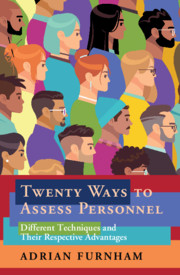Book contents
- Twenty Ways to Assess Personnel
- Twenty Ways to Assess Personnel
- Copyright page
- Dedication
- Contents
- Tables
- Preface
- Acknowledgements
- 1 Introduction to Selection and Assessment
- 2 Complex and Sticky Issues in Assessment and Selection
- 3 Traditional and Mainly Discredited Assessment Methods
- 4 Self-Report Tests
- 5 Observer Reports
- 6 Behavioural Tests
- 7 Physiology
- 8 Biography
- 9 Big Data
- 10 The Future of Assessment
- Index
- References
6 - Behavioural Tests
Published online by Cambridge University Press: 11 June 2021
- Twenty Ways to Assess Personnel
- Twenty Ways to Assess Personnel
- Copyright page
- Dedication
- Contents
- Tables
- Preface
- Acknowledgements
- 1 Introduction to Selection and Assessment
- 2 Complex and Sticky Issues in Assessment and Selection
- 3 Traditional and Mainly Discredited Assessment Methods
- 4 Self-Report Tests
- 5 Observer Reports
- 6 Behavioural Tests
- 7 Physiology
- 8 Biography
- 9 Big Data
- 10 The Future of Assessment
- Index
- References
Summary
This chapter covers five very different ways of assessing people by measuring their behaviour and choices. By far the most sensitive issue is the measurement of intelligence. Whilst the academic literature is very clear: intelligence can be easily and accurately measured and is highly predictive of many aspects of daily life (including work productivity), in the ‘practical world’ of Human Resources people are very cautious about using these tests because of established group differences. The chapter also looks at unobtrusive measures sometimes called snooping, which is concerned with how certain features of our life (office/bedroom layout) give a surprising insight into an individual’s personality and values. The chapter also considers situational judgement tests, which describe or show a typical workplace situation and candidates are required to select the best response. Fourth, the chapter looks at the definition and measurement of creativity, which remains something of a backwater in psychometric research, though selectors rate it very highly. Finally, the chapter looks at gamification, which involves the assessment of people by how they play various electronic games.
Keywords
- Type
- Chapter
- Information
- Twenty Ways to Assess PersonnelDifferent Techniques and their Respective Advantages, pp. 278 - 395Publisher: Cambridge University PressPrint publication year: 2021



